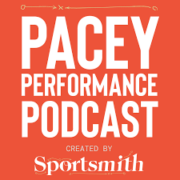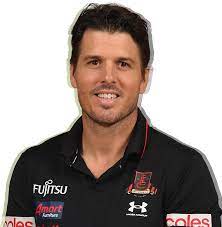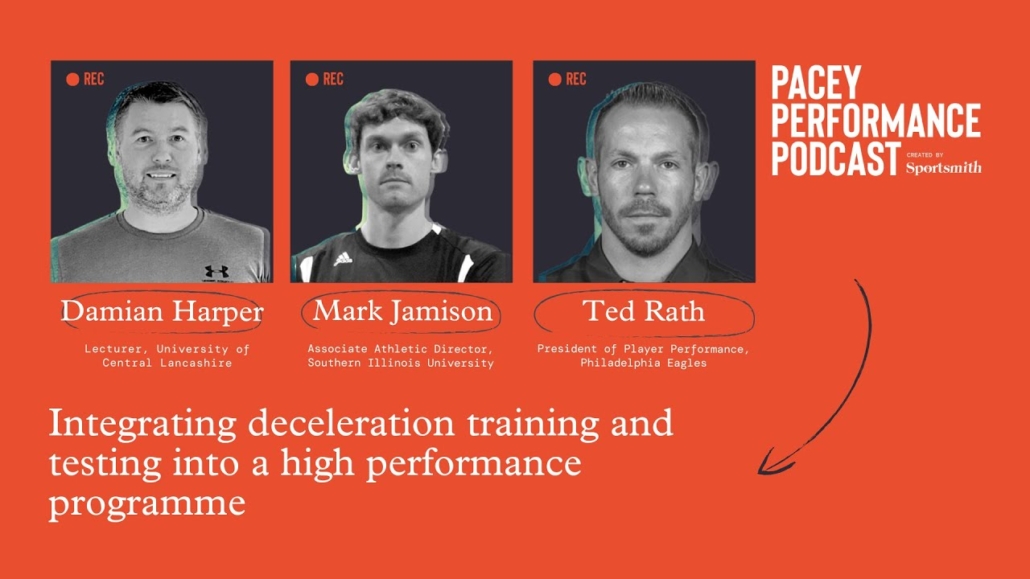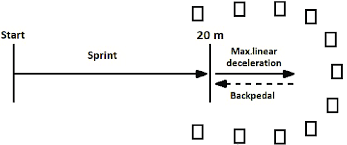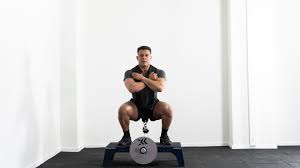Pacey Performance Podcast Review – Episode 443
Episode 443 – Nick Kane – Managing hip and groin injuries and developing a robust injury prevention strategy
Nick Kane
Background
This week on the Pacey Performance Podcast, Head Physio at Essendon Football Club, Nick Kane talks to Rob about how to rehabilitate groin injuries and how to set up an injury prevention system in team sports.
Not only is Nick the Head Physio at an AFL club but he runs his own practice and is founder of the Sports Map Network, a resource that educates physios through multiple mediums.
🔉 Listen to the full episode with Nick here
Discussion topics:
‘‘As a general global approach when it comes to returning an athlete who has suffered persistent groin injuries rather than the one off, what is your general approach when it comes to groin injuries?”
”I think it’s a well rounded question, and I think as you eluded to there, the context is probably being is those injuries that come in after a few months of having groin pain as opposed to someone who is saying my adductor is a little bit sore after a game at the weekend.
First and foremost is nailing down a diagnosis, so you know what you are dealing with and what stage of pathology and letting that guide where to start. Enda King would always say, ”it’s either for rehab, or it’s not,” so if it’s not for rehab there is a pathway you need to work through, but if it’s for rehab, this is what we are about and we need to start our process. Anything around the groin is usually for rehab.
When I look at my groin process, that starts with looking at the athlete as a whole and nailing down what I think is contributing to that pathology. So that starts with a thorough assessment and looking through some functional stuff:
- Overhead squat
- Single leg squat
- Hopping
- End range calf raises – ability to hold that position
- General Range of Motion Assessments – pick out imbalances
- Strength assessments – hip abduction/adduction, hip flexion/extension, abdominal loading
So with this you can build up a picture of what you think are your big rocks and what are the big rocks you are going to attack first? With groins you can pick everything, and go at everything, but if you can pick the big 3 that you are going to go after- such as hip abduction/extension weakness on the right side, if there is a clear imbalance there, then that’s probably going to be pretty high on your list of priorities. You’ll generally find hip strength is right up there on your big rocks.
In terms of the physio table assessments, I might be looking to see what can change your pain to guide where you are at, such as what actually improves your squeeze power? If I go hard on some hip and glute exercises does that improve your squeeze power? If I do some timing or work on lumbo-pelvic hip complex (LPHC) positional changes, does that influence our clinical tests? A bit of pelvic posterior tilt or embracing some abdominal work does that suggest that some of that LPHC work is guiding some of our symptoms? So we can start there.
‘‘Out of those exercises that might present pain, what kind of objective data are you getting off any of those assessments, where are collecting your objective data from?”
”It’s probably initially having a look at those aspects as a visual representation of where they are at, and picking out what you are seeing. So, before I move onto some really true objective bench marking, it’s more about, okay, their single leg squat doesn’t look too good on the right side. I go and test their hip abduction strength and that’s clearly showing a deficit, and then their hip extension strength might also show a bit of a deficit. So that’s clearly bringing that level of importance up higher for me. So, it’s more about stepping from there away, and then probably working our way through some of key objective testing to really see if that marries up.
Objective Testing
- Isometric Hip Abduction test – 2-2.5 x bodyweight
- Isometric Hip Extension – in a 45 degree position off the end of table with a force transducer – 9-10 x bodyweight
- Isometric Hip Abduction/Adduction – often look for close to 1:1 ratio
- Isometric Hip flexion (90 degrees and 0 degrees) squeeze test
- Lumbo-pelvic hip complex (LPHC) test – double leg lower- lowering down and controlling that without falling into some anterior tilt. I would like them to be able to lower all the way to the floor without losing their lumbo pelvic control.
Initially I wouldn’t look at some of the trunk capacity tests like side plank and plank holds etc
It is a balance between both our clinical benchmark testing and also what we can produce in the gym to get a bit more of a level of capacity and function in our bench marking, so as physios we our extending our-self more from the physio room and into the gym to tease out some of these capacity and strength markers. If we are a physio and it’s not our skill set within the gym, then it is certainly about working with someone (S&C coach) who that is, so I’d encourage the physios to link up and work through what they are seeing and what the S&C coach is seeing to tease that out.
Gym Assessments
If we start with the end in mind, we want to have the highest level of capacity and tolerance so that they don’t break down again on the field. So need to think about where we want the athlete to be at that point, where are they now and how do we get there?
We know that the loads and the forces and the preventative effect of the long lever Copenhagen test is really important so getting them to that level is part of what we do, and it’s probably not the stating point if they have been coming out of some pain and function probably won’t be able to do that.
- Copenhagen long lever – 30 sec hold isometric or 2×10 if it’s eccentric/concentric work
- LPHC Capacity test – Side plank 90-sec and Front Plank 2 minutes
- Single leg squat – really good SLS, 1 set of 10 pistol squats down to 90 degrees free standing in good form and fashion
- Split squat – pain free under some decent load – at least 30kg in a split squat biasing that rear leg position for some rec fem load
- High level Abdominal function– clean reverse ab curls or exercises such as Hanging leg raises
- General Strength – not forgetting general bench marking such as leg press, squat, deadlift and hinge targets relative to bodyweight.”
‘‘What are the common mistakes when implementing groin rehab in a team setting?”
”Under-loading – to find the deficiencies and tease out those things, I think we are pretty good at that. If they still have some pain, how are we addressing that? Are we saying have some rest, or just do a couple of little band exercises and hope it goes away, and its still there weeks later. I think we can really get in early, and get really good loading to address what we need to do with weights etc. Go hard at it, and go hard at it early – unloading in that early and mid phase will just drag groin issues along as we are not addressing what is driving it.
Racing to the finish line – The other one is often a groin will commonly fail you if it’s a chronic groin issue, and they often won’t fail you early, they will fail late. You’ll put all this work in for 5-6 months and you’ll get them there, and there strength and capacity are let’s say 90%. Then they go and perform in games repeatedly, or high level training sessions and they break down. Essentially, they are just not taking that extra bit of time, or really nailing and having really clear benchmarks in your mind and not accepting anything less than that.
Not addressing anterior chain strength enough within rehab – hip flexion, abdominal or oblique strength. If we only hit the hip strength we may be missing out on something.
Clearly you can get yourself in a bit of a hole if you say he is going to play in 4 weeks time. It’s about buying your time setting expectations a little bit longer, and rather than setting a date in mind, it’s about working aggressively forward to make that change and putting it on the athlete early and saying this is where you are at, this is where I want you and then having making sure you are having some routine testing through the process.
Be really strong on achieving those things that you think are important and pushing to get there.
‘‘When it comes to building an Injury Prevention System, what does that look like for you in terms of an overall philosophy?’
Primary Prevention
”As a general framework and how I see myself working within this as a physio, I look at primary prevention and addressing the key risk factors that go across the sport, including:
- Knowing the common injuries in your sport
- Making sure training loads are really high
- Making sure athletes are really strong
- Making sure athletes are recovering well – eating and sleeping well
- Making sure athletes are hitting their speeds – and having a good speed exposure
Secondary Prevention
- Individualising things more in the injury prevention process – to stop an injury from becoming more sinister, or putting things in place and being more selective in our IP approach by stopping the energy leaks.
- Physio benchmarks – hip, calf and hamstring, and hopping metrics. Most people do them, but it’s more about how well you to do and how much you pay attention to detail on the results but also the process following on from that.
Fitness Testing
With most players at the start of the season, we will look at:
- hip strength (abduction/adduction)
- hamstring strength (Nordic measure)
- calf strength test– seated calf strength (on a force plate- 1.8 x bodyweight)
- calf endurance test – calf raise to fatigue
- 5 hop test (force plate)
We will look at the pie chart with all our benchmark norms and test that at least 3 times a year for some of our younger guys to see that they are improving and addressing those key areas. For some of our main group or more senior athletes a lot of them might only have one or two things that are sitting at where we want them. So then in that case we plug in an intervention (here’s your exercise or entry point, this is our load and you need to progress it like so and here’s how many days a week you do it). We will re-assess in 4 weeks and get every athlete at that level and once they are that level then fantastic, and we can go again to target something further that they think or we think will further assist them.
It’s about not over-intervening with the information you get. You could jump at shadows and think, oh his groin squeeze is down, or his hamstring power is down. But I think it is really important to know that our screening measures (and numbers we are getting) are NOT a decision making tool.
They are purely there to maybe flag something, or at least start that conversation with the physio, to say let’s look at this, and do a bit of that, then re-test that squeeze and we are away. Or maybe we are seeing some range of motion down, some pain on his groin contractions, and some early signs of fatigue or under recovery of the adductor longus. Now we want players training but clearly using our clinical knowledge and the context of where that player is at, and where they have come from, and where we are in the season, we might need to make really clear decisions about what is best for them and the team moving forwards so we are not ending up with an athlete who is struggling with groin pain for a few months. We need to pick things up early and being really aggressive with what we are doing.
Top 5 Take Away Points:
- When I look at my groin process, that starts with looking at the athlete as a whole
- Isometric testing for the hip is an important part of the objective assessment for groin pain
- Gym assessments support the physio assessments such as Copenhagen long lever
- Avoid some of the pitfalls of groin rehab by being really strong on achieving those things that you think are important and pushing to get there.
- Avoid over-intervening – our screening measures (and numbers we are getting) are NOT a decision making tool.
Want more info on the stuff we have spoken about?
You may also like from PPP:
Episode 442 Damian, Mark & Ted
Episode 444 Jermaine McCubbine
Episode 381 Alastair McBurnie & Tom Dos’Santos
Episode 380 Alastair McBurnie & Tom Dos’Santos
Episode 372 Jeremy Sheppard & Dana Agar Newman
Episode 217, 51 Derek Evely
Episode 207, 3 Mike Young
Episode 192 Sprint Masterclass
Episode 87 Dan Pfaff
Episode 55 Jonas Dodoo
Episode 15 Carl Valle
Hope you have found this article useful.
Remember:
- If you’re not subscribed yet, click here to get free email updates, so we can stay in touch.
- Share this post using the buttons on the top and bottom of the post. As one of this blog’s first readers, I’m not just hoping you’ll tell your friends about it. I’m counting on it.
- Leave a comment, telling me where you’re struggling and how I can help
Since you’re here…
…we have a small favor to ask. APA aim to bring you compelling content from the world of sports science and coaching. We are devoted to making athletes fitter, faster and stronger so they can excel in sport. Please take a moment to share the articles on social media, engage the authors with questions and comments below, and link to articles when appropriate if you have a blog or participate on forums of related topics. — APA TEAM

